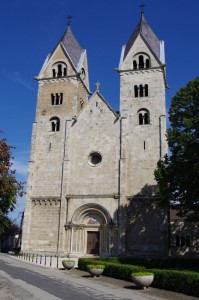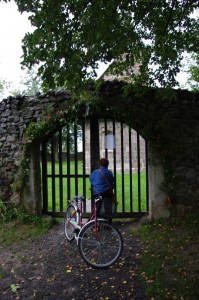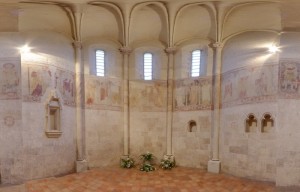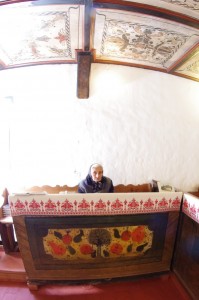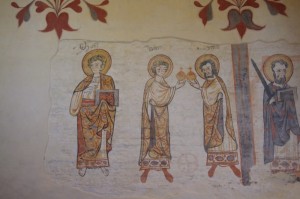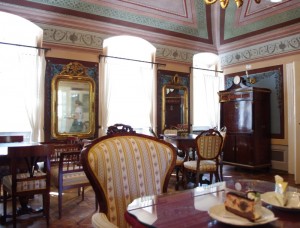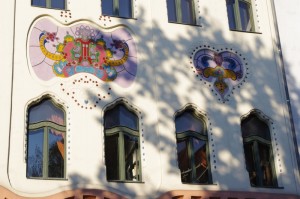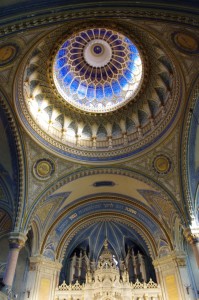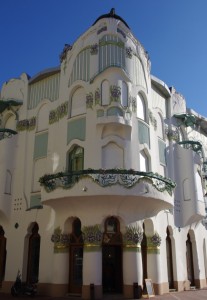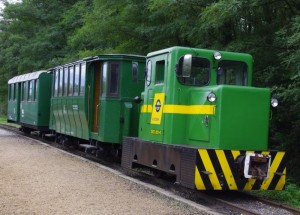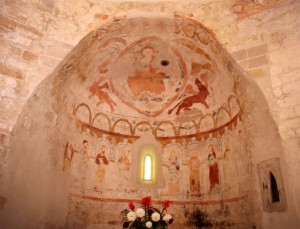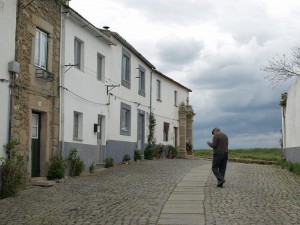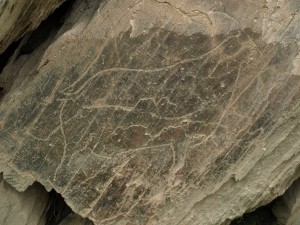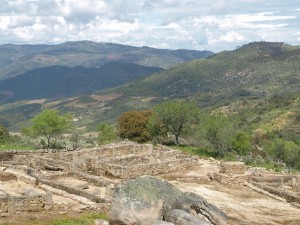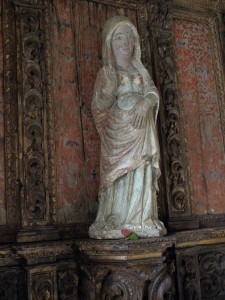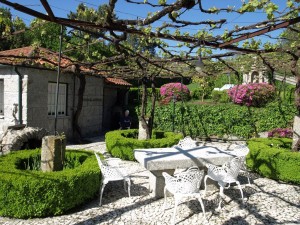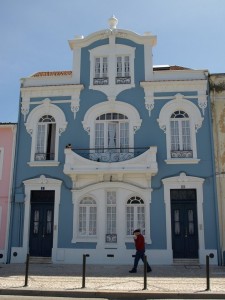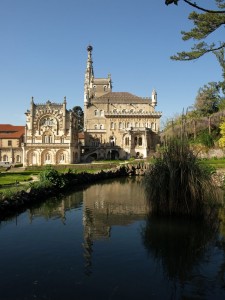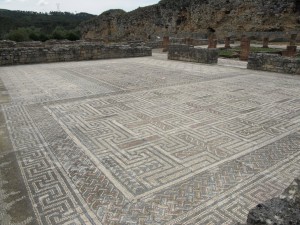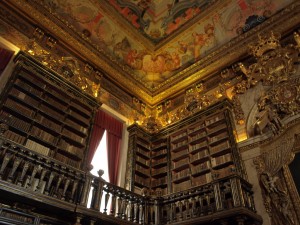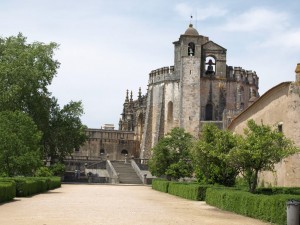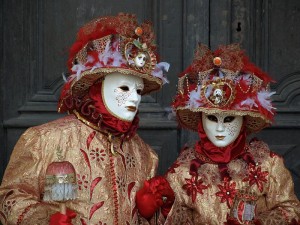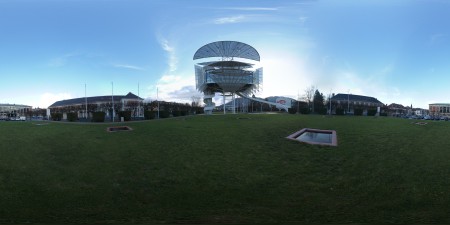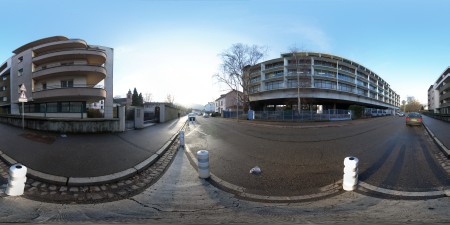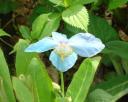There is a decoration based on some photographs of a robin I took this morning. To download the PDF file (about 1Mb) which you can print as a single A4 page right-click on this link Robins decoration and select Save link as/Save target as.
Category Archives: Photographs
Time out from Entre-deux-Eaux: Hungarian Interlude
To download a printable Adobe Acrobat version click on this link E2EYr9Weeks18-22.pdf (seven A4 pages)
Clicking on the underlined links in the text will take you to a selection of photographs. There is a comprehensive list of photographs and 360° panoramas
There is also an approximate map of our route around Hungary
Although it was a fairly impulsive decision to spend some of September seeing Romanesque churches and art nouveau architecture in Hungary, we were better prepared for this car journey than on our earlier trip to Portugal. We had enough time to update our European road maps (discovering in the process, the Michelin Europe didn’t include most of Hungary), get a more detailed folding map of Hungary, and rent a month’s Hungarian download for Gladys, the sat-navigator. Following old habits, we also stocked up on Lonely Planet guides to Hungary and Germany (more recent editions than the relevant Rough Guides), though during the journey we began to wonder if we’d reached the sad age of no longer being Lonely Planet people, as we wanted better information on art, architecture and parking (rather than tips on best bars and breast-feeding).
September can bring rain or glorious sunshine, and we got a mixture. We were fortunate to have some lovely sunny days, for also we got our share of rain and saw maize crops devastated by a summer of the heavy rain which probably also played a part in the current disaster of overflowing toxic red sludge at Ajka.
We spent a day and a half driving through Germany (wet) and across Austria (sunny). When we reached Hungary we had a rough itinerary, which included the eleven Romanesque churches which looked the most interesting on the internet, – especially those with fresco fragments. Many sounded as if they were in small villages or had formed part of remote hillside monasteries, and only three were mentioned in the Lonely Planet. So we wondered how easy it would be to locate and communicate with the keyholders. The Lonely Planet’s “conversation and essentials” section equipped us to state in Hungarian “I’m allergic to contraceptives” or “I need disposable nappies” but not to ask how we could see inside the beautiful church. However we soon found that the keyholders were the most delightful people, keen to communicate with the most oafish non-Hungarian speakers, and others helped through mime or a few shared words of German. These are three samples of our Romanesque quest:
Picture a small former mining (gold, copper, sulphur, and iron) village, Nagybörzsöny, in the north, hard against the border with Slovakia, on a wet third day. We spot the walled church at the entrance to the village, and pull in under a dripping tree. Despite the rain, we can see plenty of people with baskets, packages and bicycles further down the road. The locked gate is festooned with sodden red and white flowers, ivy and ribbons. There is a notice with a phone number, but we fail to get through on our mobiles. As we peer through the metal bars, a row of stone heads round the apse grins back at us. This is too good to miss. We walk towards the centre of the village to ask about keys. However, two buses have come and gone while we were trying to phone, and now the street is deserted. Some of the smallest thatched cottages are also empty, or just being used for storage. We pause as John spots a huge snail on a gatepost, and a man who has just got out of a car (but is unfortunately not from the village) engages in a rather surreal conversation in German about snails, the size at which they should be eaten, and how all Hungary’s get sent to France. We try doorbells, but nobody answers. We spot a lady pushing her bike up a hill and catch up with her. She does not appear to understand our questions and points to her bicycle basket. She has been out collecting walnut windfalls.
Suddenly she smiles triumphantly, opens her large handbag and flourishes a heavy key. It is hard to believe that the only person that we meet on the streets (apart from the snail-fancying outsider) just happens to have the church key in her handbag! She cycles ahead of us to open up. The church is tiny, with a single apse, white walls, simple wooden benches, a small gallery at the back and spotless white cloths on the altar and tables. There is no hint of damp and it feels loved and used. To the left of the altar is an imposing bust of St Stephen of Hungary, and to the right a replica of his crown and a Hungarian flag, for this is St Stephen’s Church and it was he who established Christianity in Hungary and ordered the building of a church in one of every ten villages. As John wanders round taking photos, the lady chats in Hungarian to me, not minding that I don’t understand much. She says that they celebrated a wedding recently (hence the flowers), and as we leave, she points at the sculpted heads outside. “Tartars”, she says. The rain still falls.
By afternoon, it feels as if we are in another land as we approach Ócsa, south of Budapest. The sun is shining, the sky is blue and ladies in hot pants and spangled bras stand by the road, unbuttoning their blouses provocatively at passing cars and lorries. The church here is much loftier, with three aisles and two towers, and was built as a Premonstrian monastery on a sand-dune in the marshes, using stone brought down the river from Buda. Outside, the stone glows lemon-gold in the afternoon light, and inside faint reds and yellows on the choir walls take the shape of mediaeval figures – Jesus crowning Mary, the disciples, fragment of the last judgement, St Ladislaus I of Hungary on his white horse, St Nicholas and St. George (look, no dragon). When the Turks occupied the area, they whitewashed over the murals and used the church without destroying it (apart from sharpening their weapons on the stone by the doorway). Unlike this morning, the telephone number on the door worked and Judit is a mine of information, which she is anxious to communicate. She has clearly looked up all the technical and architectural terms in English, but finds the verbs and joining words harder. As John takes photographs, she confides that the church has become very important to her, although she is not a Catholic or Reformed (which the church became after the Turks left and new people repopulated the area) but a Baptist (with an uncle who is a Baptist in the USA and knows Billy Graham). The church has a congregation of 300, 100 of whom are young people, and the choir has produced a CD. We continue to feel a world away from St Stephen’s this morning, as we thank Judit profusely for our informative guided tour.
Two days later we realise that the easiest time to see the lovely old churches is at the weekend, where local guides are on hand to instruct coachloads of Hungarians with a half hour lecture before they are allowed to look round. It is Saturday, and sunny and we have reached the Bereg region in the north east corner of Hungary (close to the borders with Ukraine and with Romania), where the Lonely Planet promises village life “steeped in folk culture, replete with dirt roads, horse-drawn carts and little old churches … where some women still eke out a living embroidering pillowcases in age-old patterns and men work the land.” This sounds to us like the scenes we glimpsed from the train as we travelled north in Romania, and we are looking forward to staying in the area, and exploring in a leisurely fashion. We stop first at Tákos to see the small white wattle and daub Reformed church, dating from 1766, and find that it is not only open but its pews are crammed with visitors listening to an old lady in a black headscarf holding forth authoritatively and at length. As we wait outside we are amused to see the embroiderers rush out as soon as coaches are heard to drape themselves and their cross-stitch embroideries picturesquely over plastic garden benches. After the second coach-load has left, we have a few minutes in which to revel in the painted wooden ceilings, pews, gallery, pulpit and huge high-backed seat and the red, white and blue embroidered cloths. It reminiscent in its painted simplicity of some of the old wooden Swedish churches. The old lady, takes one look at us, decides her words will be of no use, and waits patiently for proper visitors. When we go outside the embroideries and plastic chairs have disappeared.
At the next village of Csaroda we are back to Romanesque, this time in a beautifully tended garden. Here too, the church doors are open and another shrill, but more elegant church guide is holding forth. The inside is lovely, with its fourteenth century frescoes uncovered from beneath flamboyant seventeenth century red tulips and leaf patterns. St Peter and St Paul smile on the north wall below the tulips, together with Job, two Byzantine “doctor holies” (as the useful English printed summary describes them) and a “woman holy.” At the front are the 12 disciples and the suffering Christ, and on each side of the window recess a crowned figure. Together with the embroidered cloth and the rugs, the effect is colourful and exotic.
And meanwhile, how were we getting on with finding accommodation? On our first night we’d realised that the Lonely Planet’s selection of hotels and pensions in pretty mediaeval towns didn’t work for us if the area is pedestrianised and all parking occupied (besides, we hadn’t worked out meters or parking permits) and we followed a sign to a more conventional business type hotel. Our second night was in a huge room in a family hotel near the Slovak border. On our third night, after the glories of Nagybörzsöny and Ócsa churches, we headed east towards the mountains and chose the Panorama Pension and a room with a wonderful view. It is also an activity centre complete with a summer bob-sleigh-on-tracks run. The staff spoke no English or German, but were determined to be helpful. It transpired that we were their only guests. Yes, we could have dinner, but the chef finishes at 6pm. We drove down a winding road to the small town for dinner (deer casserole served by a caricature waiter, – fat, boozy and cross-eyed). We felt very solitary as we returned to our dark mountain retreat as the rain set in. By morning the view had disappeared completely under low cloud, which was a shame. As we approached Tokai on our fourth night, it was obvious that the main tourist season was over and we were a rarity. A sign outside a neat house offered rooms, and though Angie and her husband were in Germany, her daughter made us welcome us and laid on a wonderful breakfast in the family kitchen (by contrast we dined and sampled Tokai wine in an elegantly gloomy four star hotel). So all relatively simple and varied so far. But unfortunately, after the wonderful churches (and embroideries!) of rural Csaroda we run into problems, as the only lodging house, opposite the church, is closed. We find a rather sleazy hotel in a nearby village, but there is something unsavoury about the unshaven young man who emerges from the bar, and it can provide neither evening or morning meals. And in the nearest town, there is a big fair and all hotels are fully booked. We drive south, as the light fades and the rain starts to pour down. For miles we find no signs for rooms, let alone pensions or hotels. By now we are out of the pretty “peasant” area and on the edge of a town, with hotels with flashing night club signs. My memories of the Hubertus will be of a chain-smoking, but very kind, manageress (who fits my stereotype of a brothel madame as she leads the way up the dark panelled staircase with its worn red carpet), a bathroom with a peach suite and a turquoise shower curtain plus red velvet curtain to draw in front of the loo, and the most disgusting deep-fried wiener schnitzel and chips (Little-Chef style). So much for the LP’s “The pleasures of far, far north-eastern Hungary are simple and rural ones.”
However, the LP is very good on highlighting two things, – art nouveau buildings and good cake shops. When we reach the south, we intend to focus on the towns of Kecskemét, Szeged and Pécs with their art nouveau palaces, cinemas and synagogues. And en route John is keen to experience the Great Plains. Having abandoned the embroideries and horse-drawn carts of the north-east a bit earlier than planned, we throw in a couple of extras in the south-east: the “burial” mounds at Vésztö and the town of Gyula, home to Hungary’s second oldest cake shop. Vésztö is pretty deserted in the rain apart from us, one other couple and the birds from the nature reserve. The layers of archaeology from Neolithic to bronze age to Romanesque monastery are amazingly intact but a little confusing. Afterwards, the cakes and the elegance of the Biedermier furniture and mirrors in the Gyula teashop turn the wet Sunday afternoon into an agreeable detour.
The road from Gyula to Kecskemét is lined with water-melon stalls, which look as if they’ve fared much better in gardens than the fields of maize and blackened sunflowers. After reaching Kecskemét, we are seduced into staying a second day by the returning sunshine, pavement cafés, fountains, museums, good food and abundance of art nouveau (or Austro-Hungarian secessionist style) architecture. We also relish our pension with its verdant courtyard garden, great breakfast, friendly owner and immaculate rooms (pink and tiny in our case, as the larger garden rooms are taken – it feels a bit like sleeping in a Barbie house). So after simply strolling round on the first afternoon and having a splendid dinner (in an art-nouveau brasserie style setting, of course) we are more earnest on our second day. We visit the big morning market (colourful flowers and vegetables outside, and meat, cheese and pickled vegetables inside), then the ornate Council Chamber. We admire the art nouveau architecture (despite the strange roof ornaments which have a distinctly Disneyland look), 20th century paintings, old photographs and gold grave goods in the Ornamental Palace. After a pause for the best-ever Sachertorte and coffee at Vincent’s, we proceed to the museums of naïve art and of Hungarian crafts. Dinner in the evening is at a more traditional restaurant/bar, very filling and jolly too with men are playing (for money) with huge cards with Roman numerals.
Next we head for the university town and home of paprika, Szeged. On the way we stop at a large memorial/heritage park. The part that interests us most contains re-constructed houses from the area, which from the outside look like the houses we have driven past, so it is fun to see inside. Not only are “inhabitants” on hand to chat about their lifestyle (the miller’s wife is also busy whitewashing the big mill), but the gardens are full of typical produce, there are pigs in the sties, chickens pecking around, peppers strung up to dry, and the loos outside the school are much as I remember from junior school.
The first place we head for in Szeged is the old synagogue. The synagogues in Tokai and Kecskemét had seemed large, but this domed, yellow brick edifice in gloomy overgrown shrubbery is even larger (and would look at home on the Cromwell Road). Inside the walls and dome are an opulent cream and blue starred with gold, and the windows are colourful but the atmosphere is dusty and sad. The long, long lists of those who perished in the last war are engraved round the entrance hall, – a thriving community martyred. John replaces his borrowed yarmulke (it suited him) in the box, and we continue past an unexpected Indian/Pakistan restaurant to look at the art nouveau architecture (especially the flamboyant mauve irises over the walls of the Reök Palace) and the river Tisza. The streets and squares are very busy, with trikes, scooters, hoppers and stilts being packed away in one square as children leave with balloons, people queuing with large containers at one of the fountains, and trams and cyclists everywhere.
Later in the evening the traffic comes to a standstill as a whistling and shouting procession of cyclists with torches encircles one of the squares. Students? But there are children and older people too. Two policemen say they don’t know what it is about. Later still, in the cathedral there is a concert of modern, haunting music. And as we stand under the Heroes’ gateway in the dark, trying to make out its murals, the car headlights flash past. We don’t get to the salami and paprika museum, but we have our most memorable meal here, no not Ind/Pak curry, but chicken stuffed with asparagus with a pesto sauce and parmesan or chicken with roasted vegetables and cheese and leek sauce, followed by a chestnut soufflé. The chef has just been lured to Szeged from Budapest.
Pécs, the last of our southern cities, is equally enjoyable. We reach it via small scraggy vineyards, fields of scarlet pimentos being harvested, and a single track forest railway line which seems to have packed up for the year. Pécs is in the middle of a music and dance festival, so most small accommodation is full and we don’t like the big communist era chain hotel (no wonder it still has a room) that grudgingly offers a single night. So we cram as much as possible into our curtailed stay. The highlights for us are the six fourth century Christian burial sites linked by modern tunnels and galleries beneath the cathedral precincts, the resplendent Zsolnay Porcelain Museum (including its art nouveau and art deco designs and with very informative text), the Turkish mosque (built with the stones of a Gothic church, and once more a Catholic church with a semi-circular add-on with dramatic murals) and a solitary Scot extracting the most beautiful music we’ve ever heard from a bagpipe outside Murphy’s Bar. Instead of a second night in a grotty Pécs hotel, we turn north-west to Kaposvar and an agreeable art nouveau hotel. Here we make the most of the last sunny evening, enjoying the statues, fountains, pedestrian street and art nouveau café.
And then, after driving round one end of Lake Balaton (where we might have stayed, but for the approaching rain), we are back, almost full circle, to Romanesque churches near the western border with Austria and the problems of finding the keyholder. So here are three last scenes.
The buildings round the gloomy looking church at Türje must once have been monastic but have the sad air of a former residence for delinquent boys or lunatics. However the shabby young man loafing outside is most keen to help us and does a vivid mime of an ageing keyholder who has gone home for his lunch but will return on his motorcycle (noisy revs) soon after two o’clock. As we wait, John takes photos of Bluto ignoring the old Trabant outside and of the crumbling farm buildings, and then we hear the approaching motorcycle and get a thumbs up from our helper. Inside the church is equally gloomy, with baroque flourishes, but a wonderful fragment of mediaeval mural on the south wall showing St Ladislaus on horseback in battle (in a scene reminiscent of the Bayeux tapestry), has survived the Turks and rebuilding. The mural is lovely and it’s sad the church feels neglected.
Next day, on our last afternoon in Hungary, we indulge in a ride on a narrow gauge train, followed by and a search for another keyholder. A train is just about to leave as we reach the tiny station (staffed by older children) next to the outdoor locomotive museum at Nagycenk, so we hastily buy tickets. The two wooden-seated carriages, drawn today by a small diesel engine (steam on some weekends), lurch off along the track through fields and over level crossings till the we reach the “big” (main line) station and more old rolling stock. The return journey involves a flag-waving guard leaning out of our carriage door, as the engine is now at the rear and the driver doesn’t have a clear view. This nostalgia for the old farm and forest railways has been rather fun.
Getting into the Romanesque church two km away at Hidegség proves more complicated as the key holder, Jozsef, is not at home, though his little dog makes a lot of noise. Finally the bar owner gives us his mobile number. It sounds as if he and his wife are picking apples somewhere, but in a quarter of an hour he arrives, as promised, and opens up the eastern section of the church. At first we are just stunned by the frescoes round the east window, and only later start to piece together the history of this church, built on the site of a circular Roman watchtower. Inside the church is a rotunda, but it has strong, square outside walls around it. A later baroque altar has been taken down and the more recent extensions have been separated off by a wall. With its low stone altar and old font (still in use for baptisms), it must look closer to its original shape than most churches we’ve seen so far. Jozsef lights the candles as John takes photographs of the thirteenth century central figure of Christ in majesty surrounded by the symbols of the evangelists and below them nine disciples (sadly three vanished when an enclosing wall was removed at some stage). There are also some sixteenth century disciples, in a more flowing style, round the main dome. The Turks removed the features from the faces and the Protestants whitewashed the lot. Now the church is Catholic again, and the preservation work has been thorough. As Jozsef returns to his apples, we stop for a long, warming coffee in the bar that helped us, and the rain starts again.
Sadly we have reached the end of our two-week journey round Hungary. All that remains is to spend our last Hungarian forints on a bed, dinner, some apricot and cherry brandy and a few bottles of wine, before crossing back into euro-land and returning to Entre-deux-Eaux via Lake Constance and the Black Forest. It has been a good holiday.
Time out from Entre-deux-Eaux: Portugal, volcanoes, piri-piri and football
To download a printable Adobe Acrobat version click on this link E2EYr8Weeks41-5.pdf (seven A4 pages)
Clicking on a photo will take you to a larger single image.
Clicking on one of the underlined links (e.g. food) will take you to a selection of photos.
Everyone has their own tale of volcanic ash and the disruption of travel plans. Ours began with a cookery book, Piri piri starfish: Portugal found, which Leila had given John. His bedtime reading of these recipes led to the idea of travelling to Portugal to sample authentic dishes for ourselves. Combine this with our love of train-travel and you can imagine the sequence: book a cheap Ryanair flight in April/early May from Baden-Baden to Porto, then a leisurely train journey round northern Portugal, sampling the wines and food. We would start by travelling up the Douro valley, with its spectacular scenery and branch off on the dramatic narrow-gauge railways up the Douro tributaries…
The plan was doomed from the start. First of all, research into train timetables showed that the narrow-gauge railways had got too dramatic, with fatal accidents, and were currently closed for essential work. And then of course, Iceland suffered a volcano crisis and flights began to be cancelled. We wondered whether we should postpone the trip (but then we’d miss the spring flowers) or drive down (a long journey, but the car would enable us to see more remote areas).
Late that Saturday afternoon, with planes still grounded, John returned with Bluto and a clean bill of health from the car’s obligatory controle technique (MOT equivalent), and we decided to cancel our Porto hotels, forget the train timetables, throw a few clothes in the back of the car, and start driving the following morning. Of course, although we included John’s computer and recent guide books to Portugal, we hadn’t updated our road maps for this trip, so we had a 2004 Michelin road atlas of France, a 2000 road atlas of Europe and our faithful (but already with out-of-date maps) satnav, Gladys. (At a service station we hastily purchased a Michelin map of Portugal). So we were soon struck by how new motorways have opened up swathes of rural France for rapid travel, in a way that the railways must once have done. Once out of Lorraine, we found ourselves careering through boar and deer forests towards Orleans on a motorway that wasn’t even a dotted line on our map book. The other shock was that the days of comfortable family hotels in every small French town seem to have vanished without us noticing, and we were reduced to finding a cheap hotel chain on some industrial estate near the airport on the outskirts of Poitiers (but at least there were no planes overhead).
The following day saw us crossing the border into Spain, between Bayonne and Bilbao, feeling as if the days of the highwaymen demanding every last coin had not vanished, as tolls were exacted every few kilometres. And then we lunged off down another splendid new motorway to Vitoria, with tunnels, soaring bridges, fantastic rock striations and stunning views.
On our third day, we decided it was time to slow down and appreciate a little of north-west Spain before crossing into Portugal, so we spent a morning in Salamanca, enjoying the old cathedral, elegant churches the huge Plaza Major with its outdoor cafés and young musicians in black doublets and hose. Then we drove on to the small hill-top walled town of Ciudad Rodrigo, on the Spanish side of the border. Our room in the Palacio Maldonado (lavishly refurbished downstairs and pleasant upstairs) overlooked the ramparts, a favoured route of dog-walkers, it seemed. But in place of cannons and attacking soldiers, sheep grazed peacefully between the defensive walls, and small black donkeys by the river. The fourteenth century castle, accustomed to withstanding the Moors, the Portuguese and Napoleon, had also lapsed into a more peaceful role as a Parador, and we decided to experience their “taste of the region” menu. By 10 o’clock, when we were ready for bed, the Spanish were just settling down to their food.
We crossed the border into Portugal the next morning. On the original plan, we’d have been in Porto, on the coast. This route felt like the back door into Portugal, – the scruffy route. The well-tended land on the Spanish side changed abruptly to wilderness. Once there had been fields with walls, and there must have been homes. But now it was abandoned. And then we reached the first hill-top fortifications on the Portuguese side – Almeida in its familiar Vauban star-shaped glory. Two vans with hunting horns painted on their sides hurtled through the gates to deliver the post to outlying areas.
It was a surprise, once we had walked through the impressive tunnelled gateways, to find that the village inside had the air of a Cornish fishing village, with its whitewashed walls and narrow streets. It had undergone a face-lift since the military finally left in 1928. I was particularly touched, as you can imagine, when I paused in front of the library, and was pushed enthusiastically inside by a passing inhabitant, who clearly thought it was one of the marvels of the town. It had been attractively renovated. It didn’t seem to have many books (though an old one was open in a showcase at an illustration of the fort at Agra) but the computers were all in use and chairs were being organised for a meeting or lecture. Down by the old barracks, the fire station was making its own preparations, with firemen busily washing their engines. The subterranean barracks had been turned into a museum with displays of different military periods. The pictures illustrating the Peninsular War all looked like stills from “Sharpe’s Gold”. However, listening to the commentary, it soon became obvious that Wellington’s victories against the French were due not to the fictional Sharpe and his small band, but to the outstanding Portuguese soldiers who Wellington always placed in the front of any attack. At lunch time, the small bar where we were still having coffee (after our leisurely breakfast discussing volcanic ash and alternative land and sea routes with an enterprising English couple) was popular with workmen who were served earthenware bowls of steaming food.
From Almeida we drove towards Foz Coa, enjoying the whites, purples and lavenders of the wild flowers as well as the vines, almonds, olives and freshly ploughed fields. We stopped in Castelo Melhor, and joined four congenial English people (who’d also had to make alternative travel plans) and a guide bouncing down a rutted track in an Archaeological Park landrover to some of the prehistoric rock carvings by the river. These are not in caves (like Lascaux) or under dramatic overhangs (as in the Drakensberg Mountains) but on separate bits of schist rock face, shorn off in places.
And, if they had been painted, there is no trace of paint now, just layers of overlaid scraped or chiselled lines. The guide was very good, tracing in the air all the lines we could so easily have overlooked. We examined six rocks out of the hundreds that have been found. They were noticed when a dam was being built, and all work on the dam has come to a halt since. We spent the night in a grumpy hotel in Foz Coa, dashing out in the torrential rain to the nearest restaurant. No sign of chicken piri-piri or hearty casseroles there, so John had good cod and fried potato and I had veal escalopes and chips, both accompanied by a rice and bean mix and a very heady wine.
With rain still threatening next morning we visited more prehistoric rock carvings by the river Coa at Canada Inferno, then headed towards the Douro. We were seduced by mention of ruins to detour along a cobbled narrow track between stone walls, which followed a contour and vineyards round the hillsides for several kilometres. Again the wild flowers were so pretty in the afternoon sunshine, and everything was fresh after last night’s rain. There were no houses and no people apart from some French walkers along this ancient-feeling route.
And then, below us we spotted ruined columns and walls. It was a spectacular site, in need of some explanatory panels, but appeared to be Roman, built on Neolithic remains.
As we dropped down from the mountains towards the River Douro, we were engulfed by more vine terraces, and could have drunk our way westwards at any of the great port names, (including Sandeman in his black cape). John had found on the internet a remote agrotourism hotel up in the hills for the night. It was so remote that it was hard to find (Gladys was a star here), and it was great to be welcomed on our arrival with a glass of port and the news that, as it was quiet, we’d been upgraded from a double room to our own stone cottage, with sitting room and small garden. As you can imagine, we can thoroughly recommend this new venture, with its enthusiastic young manager. Apparently his mother does all the cooking, but we never saw her enter or emerge from the kitchen. After a walk through orchards and vineyards and a bath, Mama’s locally-sourced food was served: starters of either succulent black sausage or bread sausage, followed by cod in corn bread or pork in a sweet and sour sauce, and a white wine from the days when it had been a farm. On the TV in the main sitting room Fulham was playing Hamburg, and we sank into the sofas to watch.
Next morning Mamma’s home-made pumpkin jam was delicious on the freshly delivered rolls, not to mention her chocolate cake. We headed off to Lamego for the day, but it was another diversion that proved the most enjoyable – to the Visigothic / Romanesque chapel of São Pedro de Balsemão (the oldest church in Portugal, we discovered later). We weren’t even sure that we’d found it at first, as from the side it looked a bit like a run-down factory with four-square stone walls. Rounding a corner we could see stone steps and a doorway with coats of arms. We were still uncertain, but once up the steps we were stunned to find ourselves in a small basilica with three naves, columns with Corinthian capitals, a coffered, painted, wooden seventeenth century ceiling, and a beautiful fourteenth century bishop’s tomb resting on recumbent lions.
A cheerful lady came bustling in from the courtyard on the other side, wiping her hands on an apron and pointing out all the “primitive” features and the fourteenth century Virgin of the O, the pregnant Virgin Mary. There were also fragments of Roman epigraphs incorporated into the walls, to add to the timeless feels of the little church. But then, alas, time intervened, for she was clearly anxious to serve the lunch she’d been preparing. So we drove on to Lamego and its castle, museum, churches and drab ladies’ and gents’ outfitters. But it was Balsamão that had captivated us. That evening Mama offered a choice between baked octopus and veal followed by strawberries or “pudding” (like a slice of thick crème caramel)
Having really enjoyed two nights of agrotourism, we decided to book another rural hotel, on the other side of the Douro, handy for Braga, the mediaeval town of Guimaraes and the fortified Celtic hill settlement of Breiteros. This hotel was even harder to find with just a name and place, but it seemed to be well known for miles around, as burly workmen in cafés drew us diagrams of how to get back on course and find it (road, town and street signs in rural Portugal are nearly non-existent and both Google maps and Gladys had identified only one place of the same name in the area, which turned out to be the wrong one). From the moment we reached its high walls and gate, we felt there was some mystery about it, which was perhaps well known to the locals. The man who greeted us had the air of a pirate, as he escorted us down the steps from the gate into a well-tended garden of fountains, box hedged paths, vine-covered terrace, red roses, azaleas, rhododendrons, pure white lilies, stone tables and white chairs.
Then his father appeared, and our pirate started to shuffle deferentially. Father struck John as a fallen aristo (and me as a wily lawyer). The odd duo showed us our cottage, which initially felt a bit damp, and then the main house with the sombre dining room for breakfast next morning. Clearly, promoting local foods is not part of their role, for no dinner was provided, and the nearest town of Fafe on a Sunday night was uninspiring. Over breakfast the next morning, father and son hovered in a menacing fashion, watching our every mouthful. It transpired that mother lives in Porto (in two houses), but father acquired this quinta twenty years ago, in some dodgy sounding deal where a friend first purchased but couldn’t afford it.
Father was determined that we should see a pilgrim church on a hill with a baroque staircase with fountains, but we were more keen to see the Celtic Citania de Briteiros. This is an amazing archaeological site. We’ve never seen such a vast hill settlement before, nor walls which rise two to three feet high. John suspected the nineteenth century archaeologists of rebuilding many of the walls, when we saw other areas which looked like undifferentiated rubble. We spent a long time there in the heat of the mid-day sun, and also enjoyed the small museum in the village, then drove on to Braga behind a car whose hobbit-sized owner had imbibed excessively. We strolled round Braga, rather overwhelmed by the exuberant jungle of carvings on the cathedral’s organ and the gilded balcony choir stalls. Appropriately, we dined at the Churrasqueira da Se (Cathedral Grill) on nibbles of fishcakes, olives and sausage slices, followed by salad, grilled meat and mounds of rice and chips (chicken piri piri is still proving elusive). The patron on his barstool was transfixed by the match between Braga and Naval (so we added to our scant knowledge of the Portuguese football league), but he leapt off his stool, yelling as Braga scored the first goal.
Next morning, Father was anxious to be handed cash for the two nights’ “hospitality” before he left for Porto, and we were escorted from the gated premises by the pirate. We decided against trying to drive and park in Porto, but crossed back over the Douro outside Porto, stopped for coffee in the coastal town of Aveiro, with its art deco houses and colourful high-prowed boats, then headed south-east towards a night of extravagant pleasures at the Buçaco Palace Hotel (I’d pleaded an imminent birthday when John had expressed doubts). Like so many beautiful things, the walled forest in which the palace is situated, was created by monks. They planted hundreds of species of trees round their convent, as a reminder of Mount Carmel and a symbol of earthly paradise.
The flat, dull countryside vanished as we plunged into this lush, hilly forest, with its follies, towers and neglected chapels (along a mossy Via Crucis). We were enclosed in another world – magical, contemplative, inviting. Beneath the soaring trees were streams with decadent white lilies, winding paths, steps, cascades, formal box-edged gardens, and a wisteria walk dripping mauve flowers. And then, plonked in the middle, next to the monks old chapel, was the neo-Manueline, icing-sugar, fantasy palace created at the end of the nineteenth and beginning of the twentieth century. It had the air of a maharaja’s palace, and indeed, some of the blue and white tile pictures inside depicted the Portuguese ruler of India, along with scenes from the battle of Buçaco in 1810 (in which Wellington’s army defeated the French after the Siege of Ciudad Rodrigo, the Battle of Coa, and the Siege of Almeida – had we unwittingly been following the French attack route?). The forest outside was romanticised inside in huge wall paintings of minstrels, ladies, and hunters in the smoking room-cum-bar, whilst the hallway was a riot of carved white Edinburgh rock.
That evening, after a forest walk and a lingering bath, we descended to a dining room which combined features of a large railway station buffet with those of a French château. Amid the array of starched linen, wine glasses and painted walls (sailing ships in misty seas), we ordered a splendid-sounding dinner. But with the wine list starting at 1,000 euro for a bottle red and 800 euro for white (as well as 3,600 euro for vintage port) and stopping at 40 euro, John pointedly ordered beer while I splashed out on an eight euro glass of indifferent white wine. With no chicken on the menu, my companion, as they say in reviews, chose a starter of suckling pig ravioli, giblets sauce and orange zest confit, followed it with a very fiddly-to-eat steamed ray wing with raspberry emulsion, bread pudding with tomato and green asparagus, and still had an appetite for grilled wild boar with garlic and rosemary sautéed potato with cider and rapini purée tartlet (though found the boar dry). I really enjoyed my more delicate suckling pig salad with pistachios, pine nuts and marinated figs in Douro Moscatel followed by gratinated scallop and sautéed tiger prawn with pennyroyal leek confit. When the dessert trolley rattled up, we both chose the tropical fruit tart and a slab of ice-cream with walnut, vanilla and red fruit.
Not surprisingly we slept heartily and woke to an equally sumptuous breakfast laid out on the central oval table. I couldn’t bring myself to start the day with chilled “champagne” or with a cooked breakfast, but loved the three-tiered fruit bowl in the centre and the candelabra of bowls of cereals, apricots and fruit salad and the ceramic hen on its boiled eggs. After we’d explored more of the dappled forest, we drove out of the enchanted forest and back onto the scrubby plain, and the Roman marvels at Conimbriga. It was a hot day, and the noisy school groups were as bothersome as flies. But we really enjoyed the ruins, with their spectacular mosaic floors.
But it wasn’t until one of the school groups put some money in a slot we had overlooked, that we got the full benefit of Roman engineering, as reconstructed fountains (or jets of water) all round the central garden of irises, began to spray water. Such a cooling sound. The underground heating of the baths was also impressive, though we weren’t so keen on the partial reconstruction of the forum. Behind the house of the fountains rose a later, enormous, defensive wall which cut right through the rows of Roman houses, but, alas, it had failed to keep out the barbarians. The museum was good and informative and its café was great for plum juice, peach juice and the most delicious sweet pastries.
From Roman Conimbriga we moved on to Portugal’s former Moorish stronghold and mediaeval capital Coimbra (and the incongruously named Hotel Oslo). As the day began to cool, we climbed up a great many steps from the Moorish gateway, past linen and ceramic shops, towards the old cathedral and the university at the top (and not until we reached the top did we spot the yellow trams on their alternative route). However the cool blue-and-white café part way up served some of the best (and cheapest) coffee and (on the way down) beer. The old Romanesque cathedral was lovely (we never made it to the new cathedral) and we lingered there before continuing up to the glories of the university’s 18th century Joanina Library (I had to get another library in).
This reminded me of academic libraries I had worked in, with its galleries and step ladders. But nothing in my past matched the splendours (and gilding) of this Baroque library. And I had certainly never worked in a library where the bats were encouraged at night (after the tables had been covered over) to feed on any papyrophagus insects which might threaten the ancient volumes.
Back at the foot of the hill, we dined in a small family-run restaurant in a narrow street. The old man cooked, his wife kept popping out and returning with plastic bags, and a daughter waited cheerfully and briskly on a mix of students, locals and tourists. We were glad of the bread and salty sheep’s cheese as we waited for our goat in red wine to cook. Here a carafe of good house red wine cost four euro (a bit of a contrast with the previous night’s prices).
If you’ve read so far, you’ll have shared some of our impressions of Portugal’s Palaeolithic, Roman, Celtic, Visigothic, Moorish, Romanesque, Manueline, Napoleonic and neo-Manueline cultures. As our journey neared its end we wanted to spend the next day seeing something of the Knights Templar and the Jewish community at Tomar. Tomar’s small restored mediaeval synagogue was in an small house at the foot of the hill which had been used as a prison, a barn and a warehouse after the Jews were forced in 1496 to convert or flee Portugal. Now there are not enough Jewish men for a Torah service to be held (the quorum being ten), and it has become a museum. Round the wall are moving letters and cultural gifts from Jewish visitors from around the world.
By contrast, the Knights Templar Convento de Cristo up on the hill is an enormous, rambling statement of power. This monastic fortress with its crenellated walls to repel the Moors, dominates the town. The vows of poverty of the Knights Templar were not much in evidence as we wandered from one magnificent cloister to another and into the opulently decorated round church and ambulatory (did the KTs really ride their horses there?), the choir (its stalls missing after the Napoleonic troops woz ‘ere), and out again to look at facades dripping with sculpted symbols of maritime power. The T-shaped dormitory corridors at the far end were long, dark and sinister-feeling, with the arching aqueduct outside. After that I began to lose all sense of direction as we followed lower corridors, through the refectory, kitchens (which smelt of recent smoke), stables, a store-room for olive oil and firewood and another containing unlabelled mosaics and a sundial. Children’s screams and laughter could be heard at one point and people emerged from private doorways and disappeared up corridors. An ideally mysterious setting for the occasional five hour performances (with five meal breaks) of Umberto Eco’s “The Name of the Rose.” We spent that night in Constancia, and ate in a blue-tiled tapas bar (veal for me and cod for John, so little change there) watching Inter Milan versus Barcelona. The bar customers seem happy that the Italian team, no doubt due to the leadership of their José Mourinho, beat the Spanish.
Next day we saw more castles, including Almourol on its island, complete with ferryman, before reaching the border town of Castelo de Vide. There we wandered through the attractive old town, with its fountain, flowers and cats. Both the synagogue and castle were closed, by then, but maybe we’d seen enough castles for the day. So we sloped off for a beer in the late afternoon sunshine. To our surprise chicken was on the bar’s menu of the day. What better place for our last dinner in Portugal? When we returned later for soup, chicken in beer (it came, as usual, with chips and rice) and chocolate mousse, a baby was the focus of the tiny room, being passed noisily round the staff so that its harassed parents could tackle their splendid-looking skewers of prawns and chicken. Above, on the small screen, Liverpool were losing in extra time to Atletico Madrid. Our hotel that night was a former girls’ school, fully-booked by cyclists and their supporters for the following night (the next town was hosting a big cycle race). Internet comments had mentioned cramped bathrooms, so we shouldn’t have been surprised that it proved impossible to sit on the loo other than side-saddle (to avoid the sides of the small bath and large bidet-thing).
We visited the Friday market (clothes, hardware and cowbells outside, local produce inside) before leaving next day, then set out for home. We stayed in Ciudad Rodrigo again (same room even), looked round Zamora’s cathedral and castle, had a night in the Holiday Inn outside Vitoria, then decided to take a different route back through France. We had both been thinking nostalgically of our honeymoon camping trip round central France. It was a mistake to think we could recapture the old magic. The Puy de Dome looked great from a distance (and at least there was no volcanic ash), but somebody had moved all the streets of our favourite village from how we remembered them and its magical Café du Centre was closed. Tournus cathedral was somehow less atmospheric and we couldn’t find a decent coffee. And the little hilltop village of Brancion, with a Romanesque church, had been “restored” into a medieval theme park whilst the church’s amazing frescoes had been allowed to deteriorate. Then Bluto got a puncture and we couldn’t get the wheel off to put on the spare and I ended up with diarrhoea. So much for nostalgia. However, we had thoroughly enjoyed our first impressions of northern Portugal. We just need to remember – we’ll never be able to return to Portugal and have the same experiences again (although we might find chicken piri-piri).
(And, in case you hadn’t realised, the food link at the top takes you to the photos of our meals)
Photographs
Zamora
Castel de Vide
Tomar
JoaninaLibrary, Coimbra
Conimbriga Roman ruins
Buçaco Palace Hotel (neo-Manueline)
Bussaco Forest near Coimbra (panorama)
Citania de Briteiros (iron age)
São Pedro de Balsemão Visigothic chapel
Rock carvings of the Foz Coa valley
Almeida
Salamanca
Cathedral Vieja (Old Cathedral), Salamanca (panorama)
Ciudad Rodrigo (Spain)
St Philibert Romanesque Church, Tournus, France (panorama)
Remiremont Venetian Carnival 19 Mar 2010
- Click on the above image to go to the index page of the photographs
- Clicking on any photograph on the index page will open a fullsize photograph
- You can move between photographs using the arrow buttons at the top right or clicking on the centre-left or centre-right of the main image
- Press F11 when in your web browser to switch to full screen mode (and F11 to return to normal browser)
Panoramas of Bennwihr church (Alsace) and of Saint-Dié cathedral, Tour de la Liberté, and le Corbusier factory
Click on the photographs or the links below to go to the page containing the 360˚ panoramas
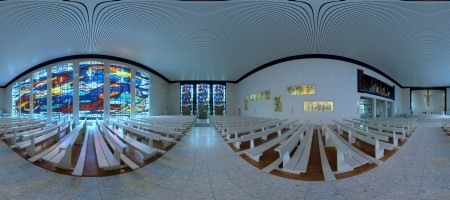
Bennwihr (Alsace): l’église Saint-Pierre-et-Saint-Paul
.
.
Saint-Dié: Interior and exterior of Cathédrale Notre-Dame de Saint-Dié
.
.
Saint-Dié: La Tour de la Liberté
.
.
.
Saint-Dié: The only factory designed and built to plans by Le Corbusier
Restaurants comments and photographs update
There haven’t been any restaurant comments added here for some time even though we’ve been eating out! We have been going back to old favourites quite often and it didn’t seem worth adding them….and then, even when we visited new restaurants, we got out of the habit of commenting.
However, there have been significant changes at our favourite restaurant of several years, the Blanche Neige. All the serving staff we knew well, from our frequent visits, left during 2008. Thomas the manager was the last to go and by lucky accident we were there during his last week in December. Then I discovered last weekend the chef had also moved on in July 2009. We’d been at the Blanche Neige in August and noted some changes – mainly reduced menu options, increased prices, and the saltiness but there was no visible indication of any change in the kitchen!
The original chef, Mike Germershausen, and his wife have now opened their own restaurant in Marckolsheim and we visited a couple of days ago. He seems to be building up a regular trade already which is not surprising as the prices are more reasonable and the restaurant is more accessible from Colmar and Selestat. The food and presentation are much the same, but slightly simpler. He said he found it a bit odd at first as the restaurant mainly served pizzas under the previous owner. When it re-opened the pizza eaters came expecting their usual food, were surprised by the menu and left again. Auberge de la Ferme Hueb, Marckolsheim
All our restaurant photographs https://www.blackmores-online.info/Restaurants/
View from the crossroads to Entre-deux-Eaux village – 9 Feb 2009
A panoramic view from the crossroads to Entre-deux-Eaux village showing a little of the winter snow.
Le Jardin de Berchigranges
Viewing point at La Bure, near Saint-Dié – 26 December 2009
La Bure, about 3km north of Saint-Dié-de-Vosges is a Celtic site where remains of human occupation dating back to 2000 BC have been found.
This is a 360 degree panorama taken on 26 December 2009 at the viewing point at one end of the site; it shows part of the perimeter walls and the valley beyond.


